Difference between revisions of "Lab 3 TF EIM"
Jump to navigation
Jump to search
| Line 5: | Line 5: | ||
#Now construct the circuit using a non-polar capacitor. | #Now construct the circuit using a non-polar capacitor. | ||
#use a sinusoidal variable frequency oscillator to provide an input voltage to your filter. | #use a sinusoidal variable frequency oscillator to provide an input voltage to your filter. | ||
| − | #Measure the input and output voltages for at least 8 different frequencies which span the frequency range from 1 Hz to 1 MHz. | + | #Measure the input <math>(V_{in})</math> and output <math>(V_{out})</math> voltages for at least 8 different frequencies<math> (\nu)</math> which span the frequency range from 1 Hz to 1 MHz. |
| + | |||
| + | {| border="3" cellpadding="20" cellspacing="0" | ||
| + | |<math>\nu</math> ||<math>V_{in}</math> || <math>V_{out}</math> || <math>\frac{V_out}{V_in}</math> | ||
| + | |- | ||
| + | | Hz || Volts || Volts || | ||
| + | |- | ||
| + | | || || || | ||
| + | |- | ||
| + | | || || || | ||
| + | |- | ||
| + | | || || || | ||
| + | |- | ||
| + | | || || || | ||
| + | |- | ||
| + | | || || || | ||
| + | |- | ||
| + | | || || || | ||
| + | |- | ||
| + | | || || || | ||
| + | |- | ||
| + | | || || || | ||
| + | |- | ||
| + | |} | ||
| + | |||
#Graph the <math>\log \left(\frac{V_{out}}{V_{in}} \right)</math> -vs- <math>\log (\nu)</math> | #Graph the <math>\log \left(\frac{V_{out}}{V_{in}} \right)</math> -vs- <math>\log (\nu)</math> | ||
Revision as of 03:08, 21 January 2011
- RC Low-pass filter
1-50 kHz filter (20 pnts)
- Design a low-pass RC filter with a break point between 1-50 kHz. The break point is the frequency at which the filter starts to attenuate the AC signal. For a Low pass filter, AC signals with a frequency above 1-50 kHz will start to be attenuated (not passed).
- Now construct the circuit using a non-polar capacitor.
- use a sinusoidal variable frequency oscillator to provide an input voltage to your filter.
- Measure the input and output voltages for at least 8 different frequencies which span the frequency range from 1 Hz to 1 MHz.
| Hz | Volts | Volts | |
- Graph the -vs-
phase shift (10 pnts)
- measure the phase shift between and
Questions
- compare the theoretical and experimentally measured break frequencies. (5 pnts)
- Calculate and expression for as a function of , , and . The Gain is defined as the ratio of to .(5 pnts)
- Compare the theoretical and experimental value for the phase shift . (5 pnts)
- Sketch the phasor diagram for ,, , and . Put the current along the real voltage axis. (30 pnts)
- what is the phase shift for a DC input and a very-high frequency input?(5 pnts)
- calculate and expression for the phase shift as a function of , , and graph -vs . (20 pnts)
